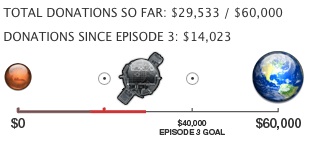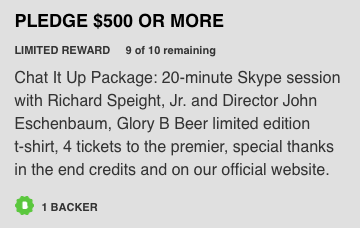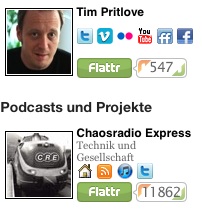Crowdfunding: get paid for free stuff
Voluntary payments are picking up pace on the web. Linus Olsson, the co-founder of social micropayments system Flattr, draws on the lessons the team has learned from their users and explains how you can be funded by your fans, too
Everything on the internet is free. News is free. Information is free. Software is free. Distribution is free. And of course, media is free. Some of it might not be legal, but it’s free nevertheless. When something can be found for free, a fixed price with a pay-before-you-get model doesn’t work and people go for the free option. Like the one you might create for fun in your spare time.
But this does not mean people don't want to pay, we know that. Voluntary payments are picking up pace and might be one solution to this situation. It’s often called crowdfunding, and it’s here, it works and creators are making a living with it. We’ve created one of the platforms for crowdfunding, called Flattr, and we’ve learned many lessons from our successful (and unsuccessful) users. Here’s a short but pretty comprehensive list to help you on your way to being funded by your fans. It’s not rocket science, but these things make all the difference between failure and success.
Participation and involvement
People want to feel like they are involved in what’s happening. Sitting behind a computer screen isn’t very inclusive and it’s one of the reasons why social proof is so powerful. Seeing others and joining them to become part of something is what people look for. If paying can get them to feel more like a part of something, they’re more likely to pay. Your fans should feel that, together, they can carry you towards success.

Create meaning
People want their money to mean something. In a perfect world, their money should be the last money needed to enable you as a creator to do what you couldn't do before. If you can tap into something your fans have showed they want you to do, it’s even better. Express the possibility that if they support you, you can invite that singer for music, post more blogs or go to that place needed to finish your documentary. This is why Kickstarter, Indiegogo, Vodo and fund gathering towards a certain goal works so well.

Karma and ego
People support charities to boost their karma, to be a good person and to feel as if they can change the world. Buying a pin that supports cancer research earns you the right to display how good a person you are. Let people show their support. Never underestimate the power of being a visible part of the social agenda.

Be important
Sorry, but nobody really want to support that which no one else is supporting. It’s hard to trust something no one else seems to know about. And the risk of the money going to waste because it’s not enough is also important.
But help can be close. A couple of friends who support you openly can be a good start towards social proof. Build on the connections you already have and don't be afraid to get too big. People have no tendency to disqualify the big as long as they feel the money will be used well. They’ll feel comforted by the fact that so many others are already involved.

Have personality
Don't be boring: people don't want to support boring people, or stuff. Ask yourself, who has the most fanatic supporters: the expressive or the inexpressive? Be outgoing and shocking! Have opinions, show you’re different.
Get the Creative Bloq Newsletter
Daily design news, reviews, how-tos and more, as picked by the editors.
If you want your supporters’ money, you’re much more likely to get it from hardcore fans than the people who think you’re standard. If you get a bunch of haters for putting your neck out, great, then your fans just have another reason to support you. Marilyn Manson knew that by being extreme he would get fans chasing him, as well as angry parents.
Be a friend
This is not only about being friendly: take the relationship between you and your fans one step further. Try to become their friend, at least in their mind. Who are you most likely to help: a random person or any of your friends? Give your fans something extra, something that only you give to your friends: the inside scoop, some secrets, becoming a part of a group of chosen few. But here is a word of warning. Don’t believe these people will give you all the money you need but trust in them to give you something even better: they will be ambassadors of your message.
Continuity
If you’ve done what you do for a long time your fans will conclude that you’ll probably continue to do it. It's important that the giver feels their money will be used for more great stuff and not for something completely different.
If what you think you did before has no bearing on what you do now, it’s time to rethink. It could still be a reason to support you. Think of it as your social CV, the one that should prove you’re worth the money. Flaunt your history of creativity.

Transparency
Be as transparent as you possibly can: it gains you trust. The more open you’re willing to be, the better. Why you need the money, what you’re going to do with it, how much you’ve got and what you’ve done with it are pieces of information that will take you a long way with your fans. The less people have to guess, the more secure they feel about giving. Supporting trustworthy people is a no-brainer: the hard part is becoming trustworthy. Transparency is key.

If you want to take one thing with you about voluntary payments, one state of mind to help you, it’s this:
People don't pay for the things they already have. They pay for the next thing, the thing that can be made, because they paid.
We at Flattr think and work for grand changes, where the trickle of many small voluntary payments form a large river. We’ve imagined and created a system that allows you to invest in the future of creators to get more of the content your love. A world where the consumers help the creators to fly.

Thank you for reading 5 articles this month* Join now for unlimited access
Enjoy your first month for just £1 / $1 / €1
*Read 5 free articles per month without a subscription

Join now for unlimited access
Try first month for just £1 / $1 / €1
The Creative Bloq team is made up of a group of design fans, and has changed and evolved since Creative Bloq began back in 2012. The current website team consists of eight full-time members of staff: Editor Georgia Coggan, Deputy Editor Rosie Hilder, Ecommerce Editor Beren Neale, Senior News Editor Daniel Piper, Editor, Digital Art and 3D Ian Dean, Tech Reviews Editor Erlingur Einarsson, Ecommerce Writer Beth Nicholls and Staff Writer Natalie Fear, as well as a roster of freelancers from around the world. The ImagineFX magazine team also pitch in, ensuring that content from leading digital art publication ImagineFX is represented on Creative Bloq.
